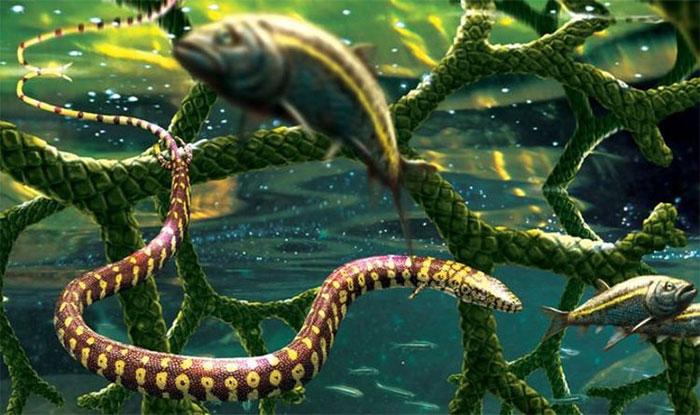Paleontologists Claim to Have Found Evidence Linking Snakes and Lizards
Six years ago, the paleontological community was astonished by the discovery of a species known as the “four-legged snake.” The fossil, found in Brazil, provided scientists with the missing link in the evolutionary tree of snakes and lizards.

The discovery of the “four-legged snake” excited scientists. (Photo: James Brown/UOP)
Research dated this peculiar creature to approximately 110 million years ago, during the early Cretaceous period, and named it Tetrapodophis amplectus.
Dr. Dave Martill from the University of Portsmouth, UK, the lead author of the paper published in the journal Science, stated at the time: “This fossil has answered some very important questions, such as whether snakes evolved from burrowing lizards, rather than from marine lizards.”
However, there was still a small issue: Researchers were not entirely convinced that Tetrapodophis amplectus was a snake.
According to new analysis by researchers at the University of Alberta, Canada, this reptile is likely a long-bodied marine lizard. This idea was unexpectedly proposed by paleontologist Michael Caldwell, who presented his findings in the Journal of Systematic Paleontology. He said: “For a long time, it has been believed that snakes are members of a lineage of four-legged vertebrates, and as a result of evolutionary specialization, they lost their limbs.”
He further explained: “Somewhere in the fossil record of ancient snakes, they still had four legs. Therefore, it was predicted that the discovery of a four-legged snake fossil was only a matter of time.”

Tetrapodophis amplectus is likely a lizard, not a snake. (Photo: Julius Csotonyi).
In the initial study in 2015, researchers claimed to have found the first evidence of a four-legged snake. Professor Caldwell remarked: “This would be a very significant discovery.”
However, he believes that the initial analysis had “some biases” regarding the anatomy and morphology of the creature. These characteristics initially seemed closely related to snakes, but according to the new analysis, the features of this creature align more closely with those of dolichosaur lizards.
The paleontologist stated: “There are many evolutionary questions that could be answered through the discovery of a four-legged snake fossil, but only if it is indeed a snake. Our main conclusion is that Tetrapodophis amplectus is not actually a snake and has been misclassified. Instead, all of its anatomical aspects fit with a group of extinct marine lizards from the Cretaceous known as dolichosaurs.”
He and his colleagues reached these conclusions based on the extracted fossil. He explained: “When the rock containing the specimen was split, its skeleton and skull ended up on opposite sides of the slab, with a natural mold preserving the shape of the opposite side. The initial study only described the skull and overlooked the natural mold, which in fact had several features that clearly indicated that Tetrapodophis did not possess a snake skull—not even that of a primitive animal.”
Despite these shocking claims, researchers believe the fossil could still reveal much information about the past.
According to co-author Tiago Simões, a Brazilian paleontologist and former researcher at the University of Alberta, Tetrapodophis has many unique features that interest paleontologists. He stated: “One of the biggest challenges in studying Tetrapodophis is that it is one of the smallest scale fossils ever found.”

















































